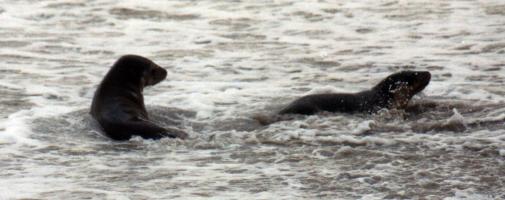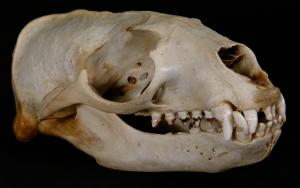
ORDER CARNIVORA
FAMILY OTARIDAE
FAMILY PHOCIDAE
FAMILY ODOBENIDAE
 |
| Australian sea lion (Neophoca cinerea) pups playing in the surf on Kangaroo Island, South Australia. |
Origins and evolution
Otarids, phocids and the walrus belong to a group of mammals known as pinnipeds (meaning feather-, fin- or web-footed). Pinnipeds are recognised as aquatic relatives of terrestrial members of the Order Carnivora and are thought to have diverged from an arctoid carnivore, belonging to the dog branch of Carnivorans. The earliest known pinniped appears in the fossil record some 23 million years ago. Otarids were the first group to split off; walruses and phocids share a more recent ancestor and are more closely related. Some taxonomists assign terrestrial carnivoran families to the sub-order Fissipedia and aquatic carnivoran families to the suborder Pinneipedia. Here we treat the pinnipeds simply as three separate families within the Order Carnivora.
General features and members of the families
Pinnipeds are generally inhabitants of polar and subpolar seas in both hemispheres; the greatest concentrations occurring around the subarctic and antartic continents.
All pinnipeds have streamlined, spindle-shaped bodies with limbs that are modified as flippers. Their large eyes are adapted to seeking out prey underwater and their mystacial vibrissae (whiskers on each side of the nose) are highly sensitive and probably serve to detect water movements caused by prey. Pinnipeds have relatively large adult body sizes ranging from small female fur seals that may weigh less than 30 kg to massive adult Southern elephant seals than can weigh over 4 tonnes.
 |
| Male and female New Zealand or Hooker’s sea lions (Phocarctos hookeri) illustrate the striking sexual dimorphism of pinnipeds: males are very much larger than females. |
Family Otariidae.
The eared seals comprise eight species of fur seals belonging to the genus Arctocephalus, Callorhinus ursinus the Northern Fur seal, and five monotypic genera of sea lion each containing only one species. In water, otarids are propelled by their fore flippers alone. They can walk well on land by supporting themselves with their fore limbs and bringing their hind flippers forward and under their bodies. Their external ears are formed of a flap of skin with a rudimentary cartilaginous support. Their pelage is waterproof and generally thicker than that of phocids; they tend to have less blubber than phocids.
 |
| An Australian sea lion pup shows how otarids can easily walk on sand. |
Fur seals
Fur seals are distinguished by their pointed faces and fur. The fur is made up of guard hairs supporting a dense mat of secondary fibers. Each follicle contains one guard hair and about 50 secondary fibers. This fur provides very effective insulation against cold environments.
 |
| New Zealand fur seal (Arctocephalus forsteri) on rocks on the Otago Peninsula, South Island, New Zealand. Its ears are clearly visible as are the very long mystacial vibrissae on either side of its nose. |
Sea-lions
 |
| Immature New Zealand sea lion showing the typical broad head and naked body of a sea lion. Its ears are visible behind the eyes. |
Family Phocidae
In water, true or hair seals (nineteen species in ten genera) propel themselves by alternate strokes of the hind flippers. They cannot walk on land as they can neither support themselves with their fore flippers nor bring their hind flippers forward under their bodies. Phocids lack external ears. All phocids have a thick subcutaneous layer of insulating fat or blubber. This family includes such well known animals as the elephant seal, the crab-eating seal and leopard seal.
Family Odobenidae
There is only one species of extant walrus (Odobenus rosmarus). Walruses are rotund: their bodies are as large in circumference as in length. They have very small heads in comparison to the size of the bodies. In water, the hind flippers propel the animals as they scull along the bottom hunting for food. On land, walruses can stand and walk on all four limbs. Both sexes have elongated canine teeth forming distinctive tusks. The tusks are used to move their heavy bodies when on land. Walruses lack external ears. Females and young are covered by a velvety pelt. Unlike male otarids and phocids, adult male walruses are almost entirely naked: their pelts are reduced to scattered hairs over its body. However, males have very thick knobbly skin to protect them when fighting.
Lifestyles
 |
| New Zealand Fur seals on land: a male, females and cubs on rocks on the South Island of New Zealand. All can move easily and quickly across this very rocky terrain. |
Pinnipeds rely completely upon the sea for food but they give birth to and suckle their young on land or on ice. They are gregarious and social animals and occur on land in large concentrations when they haul out on their breeding grounds. Males mate with more than one female and bulls and their cows live in family groups in territories defended by the male. Males are probably very large because they have to defend their territories and harems from other bulls. In addition, because bulls cannot go to sea to feed much of a bull’s body is composed of blubber to provide a store of energy to support him throughout the breeding season.
Skulls, Dentition and Diets
Pinnipeds have carnivorous diets, which vary from species to species. Most feed largely on fish and crustaceans but some eat birds and other young seals. Crab-eater seals feed on krill and are, in turn, hunted extensively by Leopard seals. Walruses sometimes feed on ringed seals. A pinniped’s dentition is modified for grasping prey rather than chewing it; as a result most prey is swallowed whole. Seals’ dentitions are more variable than those of most terrestrial carnivores.
Family Otaridae
 |
| Californian sea lion skull (Dental formula: I3/2, C1/1 PM 5/5). |
The Californian sea lion (Zalophus californianus) hunts fish and cephalopods (squid).
Family Phocidae
 |
| Harbour or Common seal skull (dental formula: I 3/2, C 1/1, post canines 5/5 = 34). The common or harbour seal (Phoca vitulina) lives in the North Atlantic and North Pacific Oceans feeding on fish, cephalopods, crustaceans and molluscs. |
Family Odobenidae
 |  |
| Walrus skull (Dental formula: I 1-2/0, C 1/1, PM 3-4/3-4, M 0/0 = 18 - 24). | |
The walrus Odobaenus rosmarus feeds on bottom-living bivalve molluscs, crustaceans, echinoderms, sea cucumbers and fish. Walruses scull along the bottom of the ocean relying on the highly sensitive skin and coarse whiskers on their snouts to find their prey in murky light or even absolute darkness. They dig for invertebrates with the tough ridge of skin on the top edge of the snouts, not with their tusks. They can dislodge invertebrates from the ocean floor by jetting water from their mouths into the sediment.
Tusks are social organs whose primary use is to signify the owner’s status in walrus society. The largest walrus with the largest tusks tends to be the most dominant animal. Tusks indicate age as the tusks of young walruses do not become visible for at least a year and a half after birth. Tusks also serve as weapons, head rests, for making holes in ice and as ice-picks. The walrus’ generic name is a contraction of the Greek words odontos and baenos meaning tooth-walk.
| Dog-like carnivorans | Aquatic carnivorans | Cat-like carnivorans |
|---|---|---|
|
|
|






